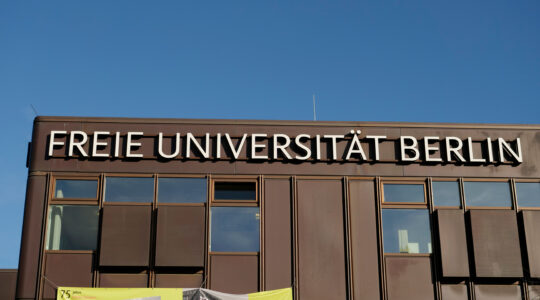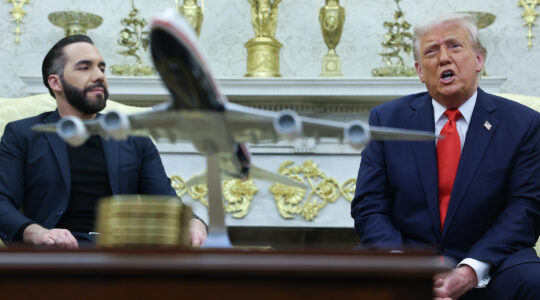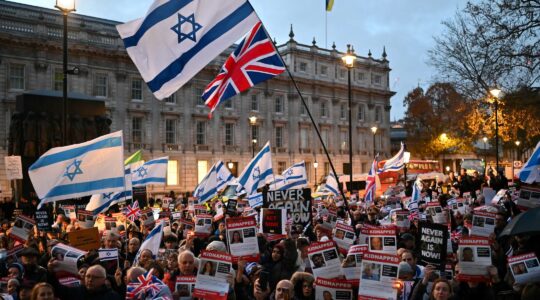
Berlin high school students attending a learning program at the House of the Wannsee Conference, near Berlin. (Toby Axelrod)
BERLIN (JTA) — Onur looks intently at the photomontage. From all the famous news images, he picks one: New York’s World Trade Center aflame.
“Did you know that the Jews were warned before to get out?” he whispers. “I read it on the Internet.”
Onur, 15, and his classmates are participating in a weeklong educational program at the Wannsee House Memorial and Educational Centre, the site where Nazi leaders in 1942 worked out their genocidal plan for the Jews.
The Wannsee House is one of many institutions in Germany today trying to counter anti-Semitism and Holocaust denial, particularly among Muslim youths.
Teachers across Germany say they face a special challenge from those of immigrant backgrounds, most of whom are Muslims. Disenfranchised from the mainstream, many of these students echo anti-Semitic attitudes heard at home, trade schoolyard insults about Jews or express Holocaust denial, testing German taboos.
“There is a problem, but you cannot quantify it,” says Micha Brumlik, professor of pedagogy at the Johann Wolfgang Goethe-University in Frankfurt. “I have heard so many teachers say that when they have eyewitnesses of the Holocaust at their schools, parents excuse their children and say they are sick. And the same happens when classes are going to visit the information center at Berlin’s Holocaust memorial or Jewish museums.”
To be sure, Germany’s problems with far-right groups are bigger than those with Muslim youths, few of whom are criminals or extremists.
But Germany, burdened by its Nazi past, is keen on combating anti-Semitic tendencies in all segments of society. Muslims are the country’s largest minority — 3.2 million out of 82 million, mostly of Turkish background. Recent years have seen a proliferation of programs designed to reach them.
Teachers sometimes take the initiative.
Ulrike Boehnke, who teaches in Berlin public schools, has instituted her own zero-tolerance policy.
“One of my kids was not allowed by his parents to go on a trip to Sachsenhausen,” the memorial at the former concentration camp outside Berlin, she recalls. “But I took the kid anyway. I have pushed, despite the rejection by Turkish parents. And most kids are really affected by the visit.”
Berlin artist Thomas Schliesser recently took a group of preteens from the Hans Fallada School to a street in their neighborhood as part of a program with the Trialogue interfaith project of the Herbert Quandt Foundation and the Neukolln Artists Association.
Placing a large sheet of white paper on the cobblestone sidewalk, he taught the children how to make a charcoal rubbing. When they were finished, they saw not only the impressions of stones but a small square plaque, one of Berlin’s so-called “stumbling block” memorials. It bore the name of Jewish resistance fighter Olga Benario, and her dates of birth and deportation to the Ravensbrueck concentration camp.
“This was put here on what would have been her 100th birthday,” Schliesser explained.
“I’ve walked here many times and never noticed it,” exclaimed one girl, Ezgi, 11.
In the background, two boys snickered “Jude” and “This is boring” until their teacher, Sabine Schonherr, reprimanded them.
“This is not boring; it’s very, very important,” she said. “Show some respect. These people were murdered in a gruesome way.”
At a program last year for educators hosted by the American Jewish Committee in Berlin, teachers said they need help countering pervasive conspiracy theories about Jews among Muslim youth.
“It’s hard to fight such theories with facts,” one teacher said. “Everything we say can be part of the conspiracy theory.”
Sometimes the programs lead young Muslims to identify with the Holocaust narrative as the victims, with modern-day Israelis as the Nazis. In this narrative, Israel’s creation — the Nakba, or “catastrophe,” in Arabic — is equated to the Nazis’ deportation of European Jewry.
Aycan Demirel, founder of the Kreuzberg Initiative Against Anti-Semitism in Berlin, says he often encounters “competition for the victim status” among Muslim youth.
“They ask, ‘Why can’t we focus on my history?’ But that does not necessarily turn into anti-Semitism,” he said.
Demirel, who is Turkish-born, says Muslim youths find him credible because of his immigrant background. His program aims to help youths recognize and reject conspiracy theories about Jews.
Some say more contact between Jewish and non-Jewish students would help curb anti-Semitic tendencies among Muslims in Germany.
For Staav Meier, it didn’t. When classmates in her ethnically diverse Berlin school asked about her unusual first name, she told them it was Hebrew.
“Suddenly I had no more friends,” recalls Meier, sitting in the library of Berlin’s Jewish high school, where she transferred two years ago.
Muslim boys and girls “waited after school for me and called me a ‘s**t Jew,’ ” she said. “Every time something happened in the Middle East, it got worse. One girl had lost someone in her family in the Lebanon war and she punched me.”
Such problems are familiar to Barbara Witting, principal of the Jewish high school. Once, when students were returning from a Kristallnacht commemoration, a group of Muslim students from another school harassed them, calling them “dirty Jews.”
“We don’t have any projects together with Muslim children because our security officials warn us against doing things like that,” Witting said.
There are some Muslim-Jewish encounter programs, however. Last summer the Wannsee House brought a group of Muslim youth from Berlin to Israel and the West Bank.
But it is likely that most of Onur’s Berlin classmates had never knowingly met a Jew when they began their weeklong program at the Wannsee House. At the outset of their visit there, the teens from Onur’s school fidgeted and whispered while educator Elke Gryglewski asked them to pick a photo of a historical event that impressed them. Finally, Gryglewski told them what had happened in the very building where they were sitting.
“Was Hitler ever here?” one student asked.
“No,” Gryglewski answered. “It was in this house that Nazi leaders decided how to kill millions of people.”
Gradually the yawning and fidgeting stopped. Gryglewski introduced the teens to Nazi racial pseudo-science, asking them if they could tell who was Jewish in a series of old photos. The students seemed surprised to discover they could not.
The Jews “were just like you, children with their own families and identity,” Gryglewski told them. “And then came the Nazis.”
Eventually Jews could not go to the movies, she went on. They could not have pets. They could not go for a walk in the park. They could not use public transport.
“Verboten, verboten, verboten,” she said.
Some Jews managed to get out of Germany, but many did not, she explained. In the end, “this is all that was left of many of them,” Gryglewski said, showing them a large photo of victims’ shoes from Auschwitz. The students leaned in for a better look.
“I used to curse the Jews, and I won’t do it anymore,” one student, Yasemin, 15, said during a break. “I used to say Jews are s**t because they hate Muslims. But now I understand better. And now I hate the Nazis.”
JTA has documented Jewish history in real-time for over a century. Keep our journalism strong by joining us in supporting independent, award-winning reporting.





